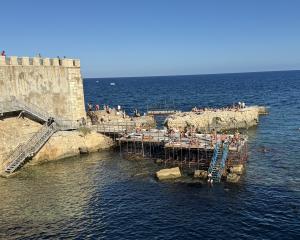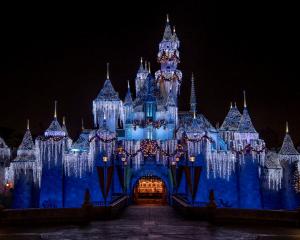

In a city of panoramas and legendary treasures the views from the upper deck are spectacular. From the Bastille to the Eiffel Tower, the Opera House to the Arc de Triomphe, Louvre Museum on to the Notre-Dame — this showcases Paris at its best.
Masterminding the complexities of dealing with 80 guests at our hotel was the role of our two tour directors as they mingled and mixed with fellow travellers for a welcoming dinner at the renowned Fouquet’s Brasserie.
Soon, everyone is chatting freely, most are Americans so it’s very relaxed and friendships are beginning to quickly form. This is going to be a unique experience for those who enjoy good food, good wine and good company.
After breakfast, we rendezvoused at the Cordon Bleu cooking academy. Paired up with aprons and hats we proceeded to whip up a batch of chocolate macaroons sandwiched together with a highly decadent chocolate ganache. After two lively hours of beating, mixing and baking to our surprise the end result would have stood up to scrutiny in any patisserie.

Recently redesigned and refurbished to the highest standards, this 5-star, 110m floating palace comes with indescribable luxury that is light years away from the hustle and bustle of the outside world.
Each of the 49 air-conditioned cabins are fitted out with superior bedding and linen, fluffy pillows, duvets and towels. The decor is rich but not gaudy with a sense of spaciousness, including a writing desk, Wi-Fi, cable TV, safe, mini bar (with complimentary beverages), floor to ceiling windows, balconies, en suite bathroom (complete with Molton Brown toiletries), hairdryers, bathrobes, slippers and plenty of wardrobe space to accommodate all your belongings.

Lyon is the food capital of France and has the most extraordinary history, much of which retains a medieval air. We found ourselves walking along narrow cobbled streets and hidden pedestrian passages. But the city’s focal point is the Basilica of Notre Dame, ‘‘Lyon’s hill of prayer’’, with stunning views over the city.
Within the commercial hub of Lyon is the Paul Bocuse Les Halle’s Market selling the region’s most famous high-end food produce, local unsurpassable sausages and air-dried meats, sensational cheeses, gateaux, pastries, pates, chocolates and fresh fruit — the list goes on.
Another gastronomic sortie and a chance to renew our acquaintance with the region’s wines and cheeses was a visit to the famed Beaujolais wine region. In another sense, this is some of the richest country in France with its thick clay soils, ripe odour and humidity.
La Legere Vineyards has been passed down through generations; the grandfather was so excited he rushed out to greet a coachload of aficionados and, through a local interpreter, showed his generous and good-humoured qualities while we rated his vintages.

Finally, we bid adieu to Lyon, the bow nudges the calm waters as we begin our epic journey gliding majestically down the Rhone, pressed up against the rails of our balcony admiring the view. It could well have been a masterpiece painting by Claude Monet.
Viviers is our next port of call, an episcopal town dating back to the 5th century. Its old quarter clusters at the foot of a massive but unfinished Romanesque cathedral with a rather beautiful interior, terraced with superb views that alone are worth the climb.
Some of us take the opportunity to learn how to play petanque rather badly at the local club while others have chosen to drive to Grignan for a walking tour of the village and a truffle farm.
Following a delicious lunch, relaxing on the top deck, we learn how the Rhone has been tamed by a series of locks that fill with amazing speed. As much as passing through the first one was a novelty, it soon became a non-event.

Arles regularly stages bullfights in its Roman amphitheatre and today we are joining the coach to visit Camargue, a 780sq km delta famous for its rice fields, white horses and thoroughbred bulls.
We are lunching at a private Spanish-styled ranch owned by the Laurent family. We are met by the entire family mounted on white steeds looking resplendent in their traditional costumes, the gypsies are serenading us and a grand Provencal lunch awaits.
Our next port of call is Avignon, its mid evening and as we install ourselves on the sundeck with a cognac and berries flambe, Captain Christophe heads the boat towards the famous Pont Saint Benezet. The illuminated wall of the city and bridges is spectacular.

A new day looms and we take a mini-train tour through the streets of Avignon for an orientation tour. The city is encircled by a 4km imposing wall complete with parapets and towers that date back to 1360.
Apart from the massive medieval palace of the Palais des Papes, the pleasure is wandering the narrow cobbled streets, some lined with buildings that are crammed together like old books on a library shelf, and the cafe-filled squares and classy boutiques.
We go back on board for a chocolate truffle presentation before we head off to Uzes where our coach is taking us to the restored Chateau Duchy D’Uzes for a cocktail reception and dinner. In the chateau’s courtyard we sipped Champagne and nibbled on canapes while a string quartet played in the background.

The following day, we travelled by coach through the Luberon, its many landscapes and flavours deriving from its crossroads position, here where the Midi meets the Massive Central.
Before we arrive at Rousillon, we have a photo stop to capture a view of one of the most stunningly beautiful villages in the region. Gordes is a little village that seems, literally, to have grown from the cliff on which it stands. This tiered village is crowned by an 11th-century chateau and is a photographer’s dream.
Then, on to Roussillon, population 1200. Its ochre earth was originally used as a pottery glaze and, as we note, the colour of the earth dictates the colour of the houses. We strolled down the narrow streets of the very pretty old quarter experiencing the texture of life as lived by the locals and stopping off to peruse the Provencal crafts spilling out from the cute shops.
As we follow the course of the upper Rhone, the grandeur of the landscape is breathtaking. From the highest peaks, the terrain slopes sharply towards the river in a terraced cascade. And there are grapes and more grapes with green pastures of vines as far as the eye can see. No surprise that 60% of the world’s wine is produced from the region of Chateauneuf-du Pape with its 320 vineyards.

Our final day is at Tain l’Hermitage and we are well primed for a busy morning. The town sits like an amphitheatre descending from the hills above and the ‘‘petit train’’ winds up and around the steep hills forever scorched by the sun. With their verdant grapevines, the show of nature is spectacular. The valley scenery is striking and one can imagine how the farmers tending the vineyards spend entire days outdoors in this peaceful agricultural setting.
Back on the coach and we travel to Valence, home of the cooking school Scook owned by Anne-Sophie Pic, a Michelin star chef, where we participate in a cooking demonstration and a wine and cheese pairing. And so, back to Tain, but not before a brief stopover at the Valhrona chocolate factory for yet another tasting.
Back on board, it’s easy to forget you’re on a luxury ship when dining. The restaurants are cosy and intimate providing cuisine that takes dining to another level with wines to match.
It wasn’t easy saying au revoir to MS Emerald. This magnificent vessel had been our home for seven days in another world. We wonder what the French meaning for unrivalled is? ‘‘Sans egal’’ seemed altogether too purposeful.
-Dennis and Rosamund Knill were assisted by Donal O’Sullivan Tauck NZ and Blis Travel Guard.
Need to know
Background reading: The Rhone River and Paris, by Ted Ringger, From Avignon to Lyon, by Aida Mollenkamp, Rhone River Cruise Guide, by Douglas Ward
Further information: Cruise World, www.cruiseworld.co.nz or phone 0800500-732











